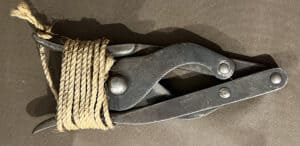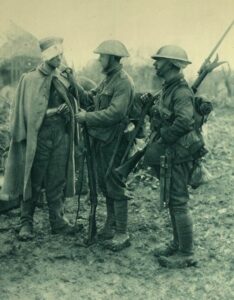Hundreds of thousands of miles of barb and razor wire were laid by both sides during the First World War. As the war transitioned from a war of movement to defensive one barbwire became instrumental to trench warfare. It offered an extremely cheap and easy way to create defence in depth. It was artillery resistant, simple to deploy and easy to replace.
Initially it was hoped that the wire could be cut by artillery bombardment, but this was quickly found to be ineffective. Instead, both sides used wire cutting parties (sappers or combat engineers) who would either precede or accompany attacks and would cut breaches in the enemy’s wire. In 1916 the British Army developed a device that would allow an individual soldier to cut the wire themselves. The device could be attached using a loop and wingnut to the muzzle of the standard issue Short Magazine Lee-Enfield service rifle, just behind the front sight. The cutter was made of stamped steel by Decimals Ltd. of Selly Oak near Birmingham, the example seen above is a No1 MkII pattern made in 1917.
The secondary photograph shows two British soldiers talking to a wounded German prisoner, the soldier on the right has a wire cutter attached to his rifle as well as his bayonet. The primary photo shows a handheld version.
The design itself was ingenious: the soldier would feed the wire into the device and then use his rifle as leverage to cut it. However, this proved extremely impractical in the field, with up to 20 m of wire to breach the average soldier cutting his own path was an easy target. They were quickly abandoned and with steel being in short supply many were melted down and put to better use.


